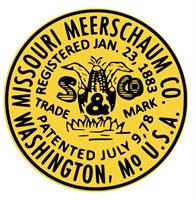The Missouri Meerschaum Corn Cob Pipe
A 150-year-old legend styled for today’s pipe smoker!
Whether you enjoy fishing, hunting, gaming, woodworking, car collecting, reading, boating, card playing or just plain living, there’s nothing quite like relaxing with a Genuine Missouri Meerschaum Corn Cob Pipe.

Using corn grown in Missouri soil and handcrafted for over 150 years in Washington, Missouri, Genuine Missouri Meerschaum Corn Cob Pipes are an American Legend – making Missouri Meerschaum the world’s oldest, largest, and leading manufacturer of corn cob pipes.
Since 1869, six generations of Missouri Meerschaum skilled craftsmen have believed there is no substitute for quality and excellence. That’s why their pledge has always been to provide the finest Corn Cob Pipes in sizes, shapes, and prices that are sure to please the most discerning pipe smoker. And they back our pledge with superior customer service, working diligently to ensure an enjoyable smoking experience.
Stop by your Chesapeake Pipe & Cigar today and give one of our cool smoking Genuine Missouri Meerschaum Corn Cob Pipes a try. You’ll be glad you did!
Company History
Washington, Missouri has long been known as the “Corn Cob Pipe Capital of the World.” And, in fact, The Missouri Meerschaum Company – the world’s oldest and largest manufacturer of cool, sweet-smoking corn cob pipes – began the tradition for which Washington became famous.
In 1869, a Dutch immigrant woodworker named Henry Tibbe first began production of the corn cob pipe. Legend has it that a local farmer whittled a pipe out of corn cob and liked it so much he asked Henry Tibbe to try turning some on his lathe. Because the farmer was well-pleased with the results, Henry made and sold a few more in his woodworking shop. Tibbe’s pipes proved to be such a fast selling item, he soon spent more time making pipes for customers than working with wood, and began full time production of corn cob pipes.
In 1907 the H. Tibbe & Son Co. became the Missouri Meerschaum Company. The word “meerschaum” is derived from a German word meaning “sea foam.” Meerschaum is a Turkish clay used in high grade pipes. Tibbe likened his light, porous pipes and their cool smoke to that of the more expensive meerschaum pipes and coined the name “Missouri Meerschaum” for his pipes. Tibbe and a chemist friend devised an innovative system of applying a plaster-based substance to the outside of the corn cob bowls. In 1878, Tibbe patented this process.
A nationwide distribution system was eventually established for the sale of Tibbe’s pipes. Other pipe firms also developed, so by 1925 there were as many as a dozen corn cob pipe companies in Franklin County, Missouri – most of them in Washington. Today, Missouri Meerschaum stands alone as the first and only surviving piece of this living history. These gentle pipes are smoked and loved all over the world as well as being used as souvenirs, often imprinted with the name of a city, business, or event.
From Cobs to Pipes
The first step in making corn cob pipes is to grow and harvest corn. When Missouri Meerschaum began production in the 1860s, cobs from any type of field corn were gathered to make corn cob pipes. However, years of hybridization modified corn to produce smaller cobs. As a result, they commissioned the University of Missouri to develop a corn seed that produces a bigger cob. Today, Missouri Meerschaum owns approximately 150 acres of Missouri farmland where they grow our corn, and sometimes they contract additional acreage with local farmers.
Shelling & Aging
After the corn is harvested, it is stored in outdoor bins until it can be shelled. Corn shelling is accomplished with a vintage sheller, since today’s newer equipment is designed to break up cobs. The cobs are then stored in the third floor of the factory for 2 years. This aging process makes the cobs harder and dryer.
Turning Cobs Into Pipes
When ready to become pipes, cobs are first loaded into chutes that carry them to the lowest level of the factory where they are sawed into pipe lengths and sorted by size. The size determines which type of pipe each will become. After each is turned on a lathe, the tobacco hole is bored into the bowl. Some pipes are bored all the way through and a wood plug inserted into the bottom of the bowl.
Then cobs go to one of several turning machines. Each machine produces a different shape. A few pipes, such as the MacArthur and the Country Gentleman, are hand turned on a lathe.
The next step is “filling,” which is applying plaster of Paris to the surface of the bowl. Bowls are then allowed to dry for a day before the next process, which is “white scouring” or sanding of the bowl to make it smooth. Bowls for less expensive pipes are varnished in a concrete mixer and spread out on wire racks to dry. Bowls for higher cost pipes are placed on spindles that rotate through a spray booth where they are coated with lacquer.
After the bowls dry, assembly begins. Wood stems are printed with ink so they appear coblike. A metal ferrule is then hammered onto the stem, and the stem is glued and tapped into the bowl. The bowls are patched around the stem, and any small irregularities in the cob are patched. Then the pipes are ready for packaging and shipping to all parts of the world!
How to Fill and Smoke Your Corn Cob Pipe

- Filling your pipe correctly is the first step in enjoying your pipe
- Draw gently, in short puffs, to produce smoke and enjoy the tobacco. Doing so will provide a cool smoke and prevent “tongue bite.”
- If this is a new pipe, it is important to smoke it all the way through. As you smoke, a carbon wall is formed inside the tobacco chamber. This carbon wall not only insulates the pipe, but also helps a pipe perform consistently.
- As you smoke, it is important to blow smoke back through the pipe periodically while smoking. It not only allows for a more consistent and enjoyable smoke, but aids in keeping the pipe lit.
- Additionally, it is essential to use a lighting method that gives a gentle flame, such as matches, a Bic Lighter, or a Zippo. Do not use a “torch” lighter.
Maintenance and Care of Your Pipe
- We advise the use of pipe cleaners when you are finished smoking your pipe; they can be especially helpful to use while smoking as well. Removing the filter, if it has one, is essential during this process. If you hear a gurgle while smoking, it is indicative of too much moisture in the pipe. A clean pipe is a good-smoking pipe!
- Allowing all the components of the pipe to cool together will help avoid breakage during disassembly. Hold the shank firmly while gently twisting to remove the bit, and only once the pipe has cooled.
- Never knock your pipe against a hard surface, but rather against something soft such as the palm of your hand. Holding the bowl (rather than the shank) while knocking out your pipe will prevent breakage.
- Having more than one pipe in your smoking rotation will allow your pipes to dry and “rest.” Dry pipes will always smoke better and last longer than wet, overworked pipes. Reliable smoking pipes are the key to a truly excellent smoking experience. Most pipe smokers recommend having a 7-day rotation.
If you have additional questions or need advice, please text, call or email. We’re glad to help!
*Most of these descriptions and tips apply to Missouri Meerschaum’s Ozark Hardwood Pipe line as well.




